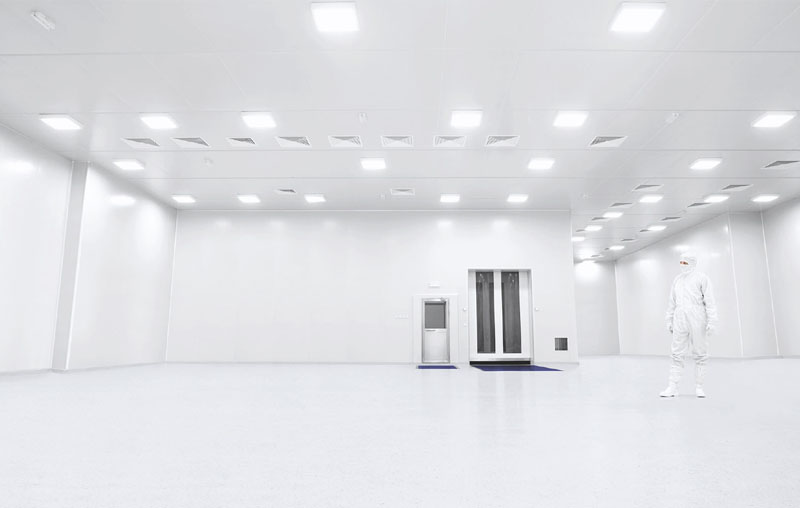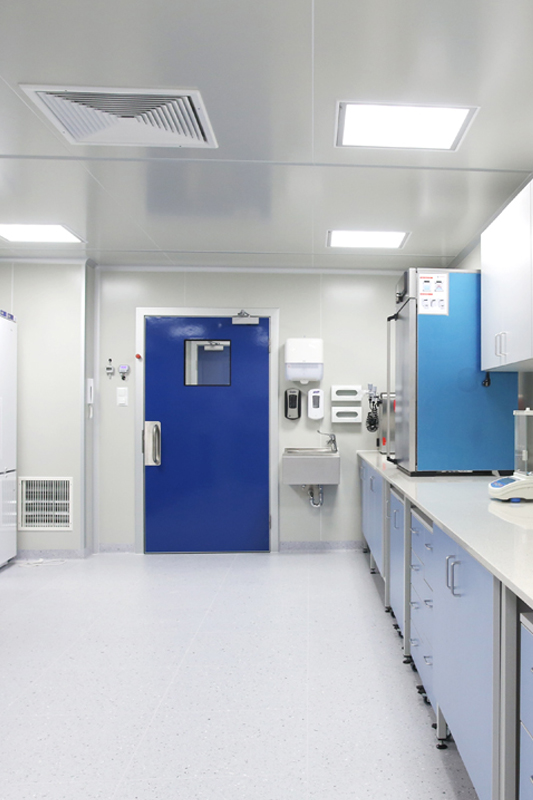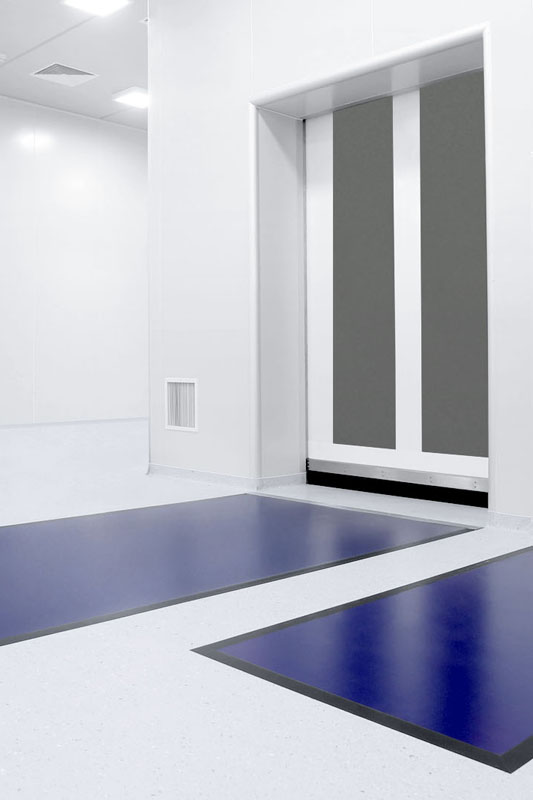Laboratory and production area management teams are constantly under pressure to increase the efficiency and effectiveness of their work. This requires maximizing space, investing in infrastructure and equipment and continuous development of skills.
The basic investment trend of recent years is the creation of laboratories in increasingly higher classes of cleanliness, construction of the so-called Clean Room.
CLEANROOM
Working with sensitive materials requires a stable environment in which at least the following are controlled: air changes per hour, temperature, humidity, room overpressure, particle sizes measured in microns,
antistatic properties, microbiological purity.
Creating and functioning of an area with such demanding environmental parameters requires building a controlled clean zone. This can be done by creating a typical Cleanroom, i.e. a complex of rooms with a cascade of pressures, or by installing the so-called Cleanbox, i.e. most often a mobile structure ensuring above all air cleanliness.
In addition, by installing a laminar air supply unit in the clean zone, the cleanliness level on the worktop surface can be increased and a cleanliness class up to ISO 3 can be easily and effectively ensured. A similar solution is the fume cupboard. If you want to control the level of humidity and temperature, for example, you can use a glove box.
Both gloveboxes and laminar air supply units can work as stand-alone points or as line assemblies. The laminar air supply units and gloveboxes are primarily used to isolate the object from the surrounding external factors. They therefore do not provide a freedom of work comparable to that of a clean room, for example, and are often installed in a clean room for local cleaning only.
In Cleanroom environments, the particles that are released into the environment and float in the air will be a source of contamination, so all sources of contamination (dirt, dust, bacteria, chemical fumes, etc.) must be eliminated, including those from equipment installed in the zone. All objects must be designed in a special way (elimination of flat surfaces, tightness, antistatic properties) and approved by the contractor for work in a specific room.
They must also be used in an appropriate manner. This is important because any object can dust and generate pollution and change temperature and humidity values. Even their indoor location is important. Not only the basic structural elements of the zone such as walls, ceilings, floors, air showers, but also furniture and even office equipment must be approved for use in the Cleanroom and used in a proper way.
CONSTANT CLEANLINESS
The proper functioning of the zone requires constant attention to its cleanliness. Depending on the class of the zone, it should be equipped with a set of measures to enable this task, e.g:
– hygienic lock for hand disinfection and shoe cleaning
– eye wash stations,
– decontamination mats,
– cleaning rollers,
– wipes,
– chemical agents.
The correct use of these resources requires a number of cleaning procedures and specialised cleaning.
Standards must be complied with in this respect and often outsourcing cleaning to an external contractor will be the most advantageous solution, also because of the economic benefits.
Research clearly shows that the most important group of threats is the presence of people in the zone. A properly trained team of employees (including maintenance services) is a prerequisite for the zone to function. The training programme usually consists of two groups of issues – general procedures covering the principles of human presence in the clean zone and specific procedures created for a given entity based on its infrastructure and research or production processes.
Clothing and footwear are also important elements of Cleanroom equipment, as they directly influence a number of key elements for the quality of work and value of research. Depending on the class of cleanliness and the nature of the tasks performed in it, the selection of clothing must take into account at least a few basic factors:
– ensuring work safety and protection of workers, e.g. against biological and chemical hazards.
– meeting standards in accordance with legal requirements
– taking into account specific conditions of the research or production process,
– quality and reliability of measurements or production,
– methods of maintenance and washing of clothing (especially important for highly specialised clothing, e.g. cleanroom, where clothing is one of the critical conditions for process efficiency and safety requirements),
– taking into account the dynamics of the user’s movements and ensuring comfortable, long hours of work.
Clothing for clean zones, must be washed in a clean zone and therefore in a specially designed laundry, otherwise it will very quickly lose its antibacterial and antistatic properties and certainly will not be allowed to be used in clean zones.
The special washing process, which takes place in rooms with controlled environmental parameters, guarantees full monitoring of dust and dirt contamination, essential for the biotechnology, electronics, pharmaceutical and related industries.
Some technological processes are associated with specific hazards, such as fumes and vapours with harmful properties. It is therefore necessary to ensure the effective removal of fumes and vapours from the working field and the continuous filtering of solid and gaseous air pollutants. Depending on the needs arising from the scale of the process, filtering equipment or an absorption and filtration system is selected.
CONCLUSION
It should be borne in mind that starting the implementation of the clean zone requires first of all the design (in practice, several projects: process, architectural, ventilation, etc.) and close cooperation between the contractor and the client. On the contractor’s side, the project of a Cleanroom is usually created by a team of engineers and each stage of design and execution is registered and accepted according to procedures required by numerous norms and standards (e.g. ISO 14644, ISO 1822, GMP, internal standards and factory procedures). Maintenance of an ill-designed Cleanroom will quickly consume more money than building a Cleanroom with well thought-out solutions.
Configuration, completion, launching, training and then service care of the whole project can be expected by the user and it is undoubtedly a convenient and effective solution, which is worth commissioning to an entity capable of overall project implementation.


